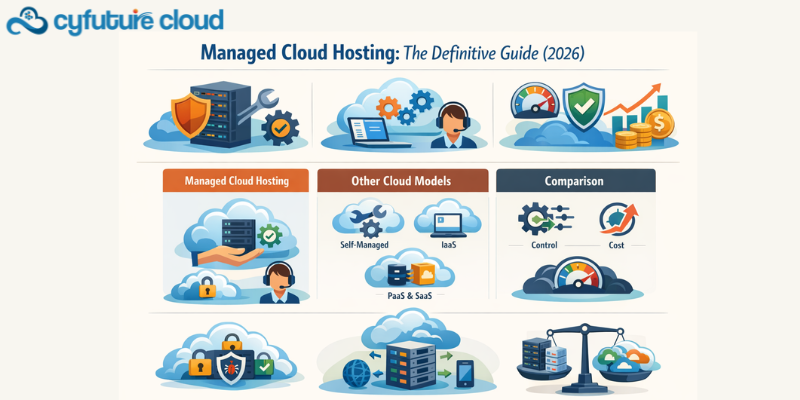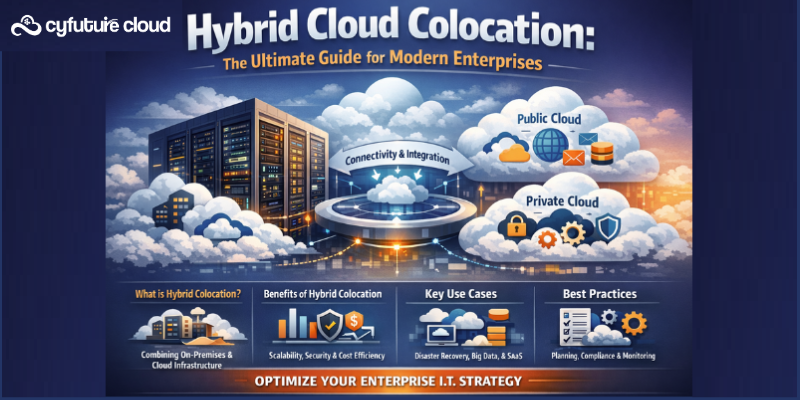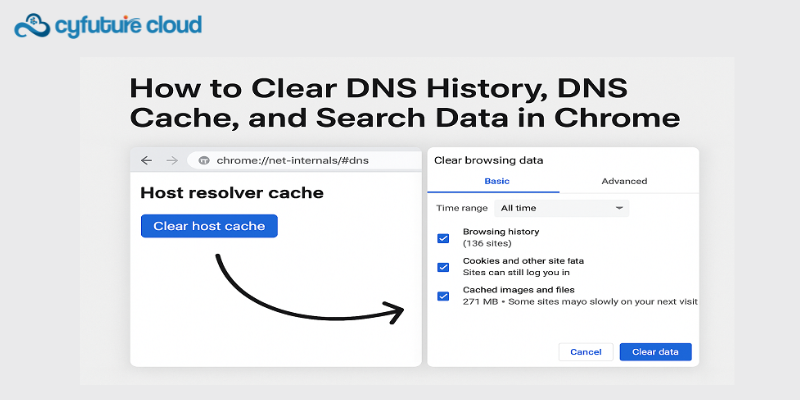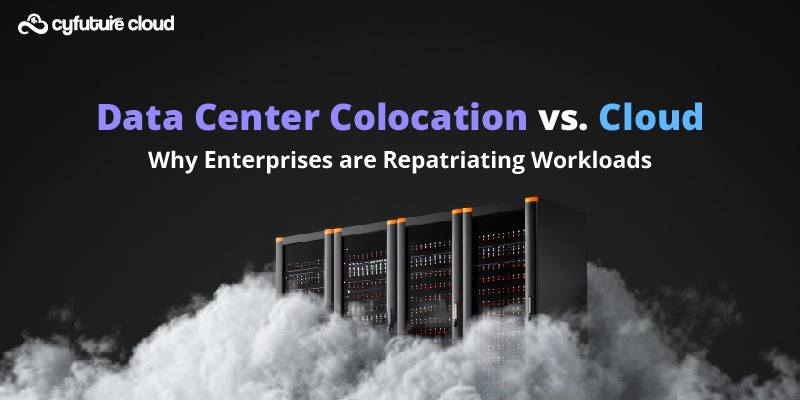Get 69% Off on Cloud Hosting : Claim Your Offer Now!
- Products
-
Compute
Compute
- Predefined TemplatesChoose from a library of predefined templates to deploy virtual machines!
- Custom TemplatesUse Cyfuture Cloud custom templates to create new VMs in a cloud computing environment
- Spot Machines/ Machines on Flex ModelAffordable compute instances suitable for batch jobs and fault-tolerant workloads.
- Shielded ComputingProtect enterprise workloads from threats like remote attacks, privilege escalation, and malicious insiders with Shielded Computing
- GPU CloudGet access to graphics processing units (GPUs) through a Cyfuture cloud infrastructure
- vAppsHost applications and services, or create a test or development environment with Cyfuture Cloud vApps, powered by VMware
- Serverless ComputingNo need to worry about provisioning or managing servers, switch to Serverless Computing with Cyfuture Cloud
- HPCHigh-Performance Computing
- BaremetalBare metal refers to a type of cloud computing service that provides access to dedicated physical servers, rather than virtualized servers.
-
Storage
Storage
- Standard StorageGet access to low-latency access to data and a high level of reliability with Cyfuture Cloud standard storage service
- Nearline StorageStore data at a lower cost without compromising on the level of availability with Nearline
- Coldline StorageStore infrequently used data at low cost with Cyfuture Cloud coldline storage
- Archival StorageStore data in a long-term, durable manner with Cyfuture Cloud archival storage service
-
Database
Database
- MS SQLStore and manage a wide range of applications with Cyfuture Cloud MS SQL
- MariaDBStore and manage data with the cloud with enhanced speed and reliability
- MongoDBNow, store and manage large amounts of data in the cloud with Cyfuture Cloud MongoDB
- Redis CacheStore and retrieve large amounts of data quickly with Cyfuture Cloud Redis Cache
-
Automation
Automation
-
Containers
Containers
- KubernetesNow deploy and manage your applications more efficiently and effectively with the Cyfuture Cloud Kubernetes service
- MicroservicesDesign a cloud application that is multilingual, easily scalable, easy to maintain and deploy, highly available, and minimizes failures using Cyfuture Cloud microservices
-
Operations
Operations
- Real-time Monitoring & Logging ServicesMonitor & track the performance of your applications with real-time monitoring & logging services offered by Cyfuture Cloud
- Infra-maintenance & OptimizationEnsure that your organization is functioning properly with Cyfuture Cloud
- Application Performance ServiceOptimize the performance of your applications over cloud with us
- Database Performance ServiceOptimize the performance of databases over the cloud with us
- Security Managed ServiceProtect your systems and data from security threats with us!
- Back-up As a ServiceStore and manage backups of data in the cloud with Cyfuture Cloud Backup as a Service
- Data Back-up & RestoreStore and manage backups of your data in the cloud with us
- Remote Back-upStore and manage backups in the cloud with remote backup service with Cyfuture Cloud
- Disaster RecoveryStore copies of your data and applications in the cloud and use them to recover in the event of a disaster with the disaster recovery service offered by us
-
Networking
Networking
- Load BalancerEnsure that applications deployed across cloud environments are available, secure, and responsive with an easy, modern approach to load balancing
- Virtual Data CenterNo need to build and maintain a physical data center. It’s time for the virtual data center
- Private LinkPrivate Link is a service offered by Cyfuture Cloud that enables businesses to securely connect their on-premises network to Cyfuture Cloud's network over a private network connection
- Private CircuitGain a high level of security and privacy with private circuits
- VPN GatewaySecurely connect your on-premises network to our network over the internet with VPN Gateway
- CDNGet high availability and performance by distributing the service spatially relative to end users with CDN
-
Media
-
Analytics
Analytics
-
Security
Security
-
Network Firewall
- DNATTranslate destination IP address when connecting from public IP address to a private IP address with DNAT
- SNATWith SNAT, allow traffic from a private network to go to the internet
- WAFProtect your applications from any malicious activity with Cyfuture Cloud WAF service
- DDoSSave your organization from DoSS attacks with Cyfuture Cloud
- IPS/ IDSMonitor and prevent your cloud-based network & infrastructure with IPS/ IDS service by Cyfuture Cloud
- Anti-Virus & Anti-MalwareProtect your cloud-based network & infrastructure with antivirus and antimalware services by Cyfuture Cloud
- Threat EmulationTest the effectiveness of cloud security system with Cyfuture Cloud threat emulation service
- SIEM & SOARMonitor and respond to security threats with SIEM & SOAR services offered by Cyfuture Cloud
- Multi-Factor AuthenticationNow provide an additional layer of security to prevent unauthorized users from accessing your cloud account, even when the password has been stolen!
- SSLSecure data transmission over web browsers with SSL service offered by Cyfuture Cloud
- Threat Detection/ Zero DayThreat detection and zero-day protection are security features that are offered by Cyfuture Cloud as a part of its security offerings
- Vulnerability AssesmentIdentify and analyze vulnerabilities and weaknesses with the Vulnerability Assessment service offered by Cyfuture Cloud
- Penetration TestingIdentify and analyze vulnerabilities and weaknesses with the Penetration Testing service offered by Cyfuture Cloud
- Cloud Key ManagementSecure storage, management, and use of cryptographic keys within a cloud environment with Cloud Key Management
- Cloud Security Posture Management serviceWith Cyfuture Cloud, you get continuous cloud security improvements and adaptations to reduce the chances of successful attacks
- Managed HSMProtect sensitive data and meet regulatory requirements for secure data storage and processing.
- Zero TrustEnsure complete security of network connections and devices over the cloud with Zero Trust Service
- IdentityManage and control access to their network resources and applications for your business with Identity service by Cyfuture Cloud
-
-
Compute
- Solutions
-
Solutions
Solutions
-
 Cloud
Hosting
Cloud
Hosting
-
 VPS
Hosting
VPS
Hosting
-
GPU Cloud
-
 Dedicated
Server
Dedicated
Server
-
 Server
Colocation
Server
Colocation
-
 Backup as a Service
Backup as a Service
-
 CDN
Network
CDN
Network
-
 Window
Cloud Hosting
Window
Cloud Hosting
-
 Linux
Cloud Hosting
Linux
Cloud Hosting
-
Managed Cloud Service
-
Storage as a Service
-
 VMware
Public Cloud
VMware
Public Cloud
-
 Multi-Cloud
Hosting
Multi-Cloud
Hosting
-
 Cloud
Server Hosting
Cloud
Server Hosting
-
 Bare
Metal Server
Bare
Metal Server
-
 Virtual
Machine
Virtual
Machine
-
 Magento
Hosting
Magento
Hosting
-
Remote Backup
-
 DevOps
DevOps
-
 Kubernetes
Kubernetes
-
 Cloud
Storage
Cloud
Storage
-
NVMe Hosting
-
 DR
as s Service
DR
as s Service
-
-
Solutions
- Marketplace
- Pricing
- Resources
- Resources
-
By Product
Use Cases
-
By Industry
- Company
-
Company
Company
-
Company
Cloud Cost Optimization: Best Practices to Reduce Your Bill
Table of Contents
Cloud computing has become the backbone of digital transformation, but as organizations scale their cloud usage, controlling costs has emerged as a top priority. In 2025, global spending on public cloud services is projected to exceed $720 billion, up from $595.7 billion in 2024—a staggering 21.5% year-over-year growth. Yet, this rapid adoption brings new challenges: up to 32% of cloud budgets are wasted on idle or underutilized resources, and 42% of CIOs say cloud waste is their biggest concern. Here’s how you can optimize your cloud costs and ensure every dollar delivers value.
Why Cloud Cost Optimization Matters
With 67% of CIOs ranking cloud cost optimization as a top IT priority in 2025, it’s clear that organizations are feeling the pressure to maximize ROI. The flexibility of the cloud, while empowering, can lead to unexpected bills. In fact, 59% of organizations saw their cloud bills rise in 2024, and 37% felt the cloud hadn’t delivered on its cost-effectiveness promise. Moreover, 78% of companies detect cloud cost variances too late, making proactive management essential.
Common Cloud Cost Challenges
- Lack of Visibility: 70% of companies aren’t sure what they spend their cloud budget on, and only 30% have clear cost attribution.
- Resource Sprawl: Idle or overprovisioned resources account for the majority of wasted spend, with 66% of waste attributed to unused resources and 59% to overprovisioning.
- Complex Pricing Models: Multi-cloud and hybrid environments introduce pricing complexity, making it harder to forecast and control costs.
- Manual Processes: Many companies still manually power down dev environments, missing out on automated savings.
Best Practices for Cloud Cost Optimization
- Understand Your Cloud Bill
- Use detailed billing and cost management tools to break down expenses by service, team, or project.
- Solutions like CloudZero provide cost per customer, feature, or deployment, helping you tie spend to business outcomes.
- Tag and Organize Resources
- Implement consistent tagging policies for all resources (e.g., by department, environment, or application).
- Enhanced visibility ensures accurate cost allocation and helps identify optimization opportunities.
- Right-Size Resources
- Regularly analyze usage patterns and adjust compute, storage, and database resources to match actual needs.
- Right-sizing alone can reduce costs by 20–30% without impacting performance.
- Eliminate Idle and Unused Resources
- Audit your environment to find and decommission unused instances, storage volumes, and orphaned services.
- Companies that automate shutdowns for non-critical resources see significant savings and improved sustainability.
- Leverage Reserved and Spot Instances
- For predictable workloads, commit to reserved or savings plans for discounts up to 70% compared to on-demand pricing.
- Use spot instances for non-critical or flexible workloads to further reduce costs.
- Automate Cost Controls
- Implement auto-scaling policies to match resource allocation with real-time demand.
- Use automation tools to schedule power-downs for dev/test environments outside business hours.
- Monitor and Forecast Usage
- Set up real-time monitoring and alerts for unusual spikes or trends in cloud spend.
- Use predictive analytics and AI-driven tools for better budget forecasting and anomaly detection.
- Adopt FinOps Practices
- Bring together finance, operations, and engineering teams to align cloud spend with business goals.
- The FinOps market is growing rapidly, with organizations adopting this model reporting up to 30% savings.
- Review and Optimize Storage
- Move infrequently accessed data to lower-cost storage tiers.
- Regularly purge obsolete backups and snapshots to avoid unnecessary charges.
- Negotiate with Providers
- Take advantage of volume discounts and enterprise agreements, especially as your usage grows.
- Don’t hesitate to revisit contracts or explore multi-cloud strategies to avoid vendor lock-in.
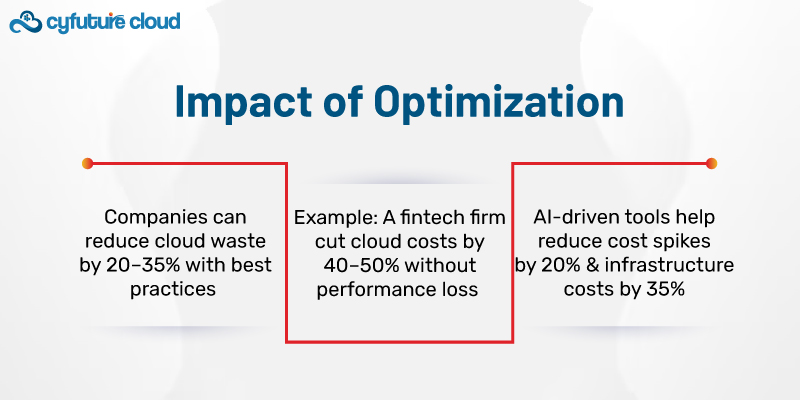
Impact of Optimization
- Companies can reduce cloud waste by 20–35% with best practices
- Example: A fintech firm cut cloud costs by 40–50% without performance loss
- AI-driven tools help reduce cost spikes by 20% and infrastructure costs by 35%.
The Impact of Optimization
Organizations that implement these best practices can reduce cloud waste by 20–35% and free up capital for innovation. For example, one company was hit with a $65 million cloud bill in a single quarter—underscoring the high stakes of poor cost management. On the flip side, AI-driven optimization and automation are helping businesses achieve sustainable, long-term savings.
Industry Trends and the Road Ahead
Cloud cost optimization is not just about cutting expenses—it’s about driving efficiency, sustainability, and strategic value. As AI workloads and SaaS adoption surge, 81% of IT leaders are increasing their cloud budgets in 2025. The focus is shifting from simple cost-cutting to maximizing business impact and innovation.
In summary: Cloud cost optimization is a continuous process that requires visibility, automation, and strategic alignment across teams. By adopting these best practices, organizations can control their cloud bills, reduce waste, and unlock the full value of their cloud investments in 2025 and beyond.
Recent Post

Stay Ahead of the Curve.
Join the Cloud Movement, today!
© Cyfuture, All rights reserved.
Send this to a friend

 Pricing
Calculator
Pricing
Calculator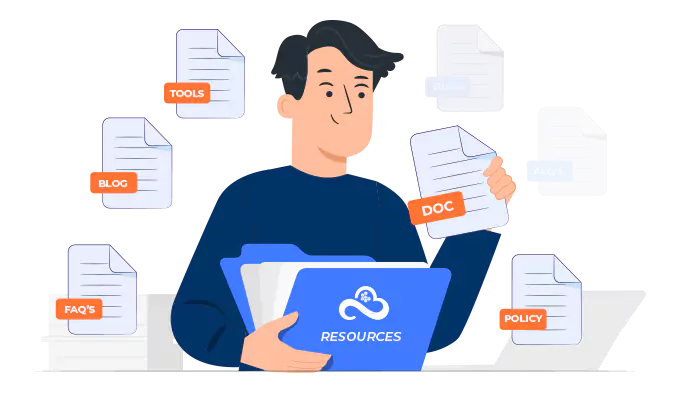
 Power
Power
 Utilities
Utilities VMware
Private Cloud
VMware
Private Cloud VMware
on AWS
VMware
on AWS VMware
on Azure
VMware
on Azure Service
Level Agreement
Service
Level Agreement 


